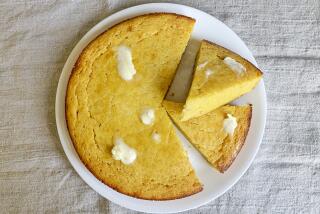Homemade mustard’s pleasurably simple punch
- Share via
Lately, I’ve been on a homemade mustard kick.
Think mustard, and your thoughts might veer first toward the bright yellow stuff you get in a squeeze bottle. Or maybe you prefer something a little less mild, as you reach for your favorite brand of Dijon or maybe a spicy whole grain.
But have you ever tried making mustard from scratch? You won’t believe how simple it is.
Essentially, mustard is nothing more than a combination of seeds and liquid. Soak seeds in the fluid of your choice (water, vinegar, perhaps a double bock beer) until they’re all softened and happy, flavor the mix as desired, then grind the seeds and, voilà, homemade mustard. (Starting the whole process with powdered mustard instead of whole seeds makes it even easier.)
I love that the condiment lends itself so readily to experimentation. Sweeten or spice the flavors here, manipulate the texture there, and fine-tune to create your own custom spread. Done right, mustard is downright magical, whether fancy or not. And nothing beats the flavor of homemade.
Start with the seeds. There are three types of mustard seeds to choose from: black, brown and white (the seed is really off-white and is sometimes called yellow), each with varying degrees of heat, or pungency. White and brown seeds can be found at most markets; black is a little tougher but can generally be found in Indian markets and gourmet cooking stores. You can find everything online.
Black mustard, Brassica nigra, is the smallest of the seeds, though it contains the most sinigrin, the compound that gives mustard its sharp punch (the burn you feel in the back of the mouth, throat and nose). Black mustard can be expensive, as the seeds must be harvested by hand, hence the limited availability.
Brown mustard, B. juncea, is a little more mild than the black and is used in most European prepared mustards. The brown seeds tend to be larger than the black but contain less sinigrin for less heat.
White mustard, B. hirta or Sinapis alba, is the mildest of all. Its large, pale seeds contain a slightly different compound, sinalbin, which typically only affects the mouth. This mustard is also available pre-ground as a powder, or mustard flour.
Those heat-producing compounds may have originally evolved to protect the mustard from predators, but, as with chile peppers and horseradish (a mustard relative), it’s that heat that makes it so enticing as an ingredient.
The trick is learning to manipulate the pungency. You can make mustard with one type of seed (or powder) or go for a blend to vary the pungency and round out the sinus-clearing harmony.
Before grinding the seeds, they should be softened by soaking in some kind of liquid. Use enough to submerge the seeds. Depending on the age of the seeds, they may absorb more or less liquid over a day or two, expanding as they soften.
The choice of liquid can also make a difference in determining the heat of the mustard. Vinegar and water are basic; I’ve found that water gives the mustard a cleaner, brighter heat than vinegar, though vinegar lends a wonderful tang. Or try wine, fruit juice, even your favorite beer. The sky’s the limit — this mustard is your creation.
When adding the liquid, consider temperature. Mustard’s punch will dissipate with heat; adding a warm or hot liquid, or cooking the mustard (some recipes are thickened with egg), can dull, even mute, the flavor. To maximize the pungency, use a cold liquid.
Then decide on the additional flavors. A mustard can be as simple as a basic Chinese mustard, where ground powder is mixed with cold water to form a fiery fresh paste. Or it can be complicated, to give the mustard more depth, the flavors forming a richer harmony. Sweeten the mustard, perhaps with brown sugar or honey. Layer the mustard with spices — a touch of cumin for an earthy note or caraway if you’re using a beer as a liquid. Add some herbs — fresh or dried — to brighten the harmony. Fruit or nuts lend a wonderful — if perhaps not so common — addition to the condiment.
Once the seeds are softened, they’ll grind easily. A number of recipes call for grinding dry seeds before soaking, but the seeds can be tough and difficult, giving your arm more of a workout than you might expect. Softening them beforehand makes it easier. Grind the moistened seeds in a food processor, then strain the mustard for a smooth, more “refined” product, or leave the hulls in the mustard for a more rustic texture.
Finally, give the mustard proper time to age. Patience is definitely a virtue here. When you first make the mustard, the flavors can be harsh and bitter. Aging the mustard will tame its personality, giving the flavors time to mellow and marry.
Once you’ve perfected it, you’ll want to make a larger batch to share. Homemade mustard makes a great gift. And no one has to know how easy it was to make.
More to Read
Eat your way across L.A.
Get our weekly Tasting Notes newsletter for reviews, news and more.
You may occasionally receive promotional content from the Los Angeles Times.











